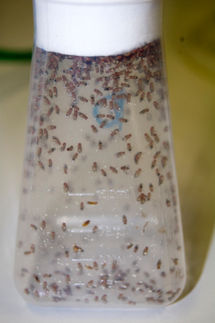In amoeba world, cheating doesn't pay
Rice, Baylor researchers find nobility among single-celled creatures
Advertisement
Cheaters may prosper in the short term, but over time they seem doomed to fail, at least in the microscopic world of amoebas where natural selection favors the noble. But why? Shouldn't "survival of the fittest" give the sneaky cheaters an edge? Not necessarily, as it turns out amoebas that cooperate for the benefit of all – and even die for the cause – bring their own genetic weapons to the fight.
Researchers from Rice University and the Baylor College of Medicine (BCM) are peeling back the layers of strategy that determine how colonies of social amoebas resist the efforts of cheaters to alter the balance of power. In work appearing in Nature, Rice evolutionary biologists Joan Strassmann and David Queller join forces with BCM geneticist Gad Shaulsky to determine how altruistic mutants help preserve cooperative behavior by single-celled amoebas.
In the paper titled "Cheater-resistance is not futile", they found Dictyostelium discoideum, amoebas that thrive on rotting vegetation in forest soil, mutate to keep "cheaters" at bay, forcing them out of the reproductive chain.
Dictyostelium fascinate researchers because so many of them willingly give up their lives to save others of their colony – a characteristic seen at all rungs on the ladder of life, but only recently studied at the genetic level. Commonly known as slime molds, these amoebas are not slimy and are not molds. They are independent, bacteria-munching creatures that live alone until the food at a particular location runs out.
When that happens, thousands of amoebas clump into a slug and move as a unit towards heat and light – signposts for food. When they reach their destination, amoebas at the front of the slug sacrifice themselves, turning into a dead, cellulose stalk. The rest of the amoebas pile on, combining to produce spores that sit precariously atop the stalk until wind, insects or other outside forces can carry them to a better place. The whole construct, known as a fruiting body, looks like a tiny balloon on a string. However, during the journey some Dictyostelium do their best to stay in the back of the slug, thus avoiding the fate of the 20 percent of colony-dwellers that die for the good of the collective. The cheaters quite happily take Gen. George S. Patton's advice to heart: Good soldiers don't die for their country, they make others die for theirs.
By that logic, the researchers noted the cheaters should dominate. But altruistic amoebas – at least those that survive – seem to know when there's a fink in the ranks, and draw upon weapons in their genetic code to keep cheaters at bay.
"In some ways it's no surprise that resistance to cheaters has evolved," said Strassmann, Rice's Harry C. and Olga K. Wiess Professor and co-author of the paper with Queller, the Harry C. and Olga K. Wiess Professor of Ecology and Evolutionary Biology; Shaulsky; BCM professor Adam Kuspa; Lorenzo Santorelli, who earned his doctorate at Rice, worked on the project at BCM and is now a postdoctoral fellow at Oxford; and primary author Anupama Khare, a graduate student in Shaulsky's BCM lab.
"In this study Anu has demonstrated so clearly and cleanly such a response to cheaters at the molecular level," said Strassmann.
The researchers found that cheater cells inserted into a population of mutants would "select" Dictyostelium strains that contained a particular resistor gene. Strong cheaters would push a high percentage of altruistic cells – for whom resistance was indeed futile – to the front of the slug, where they would do their duty and die. But a small percentage of resistant amoebas refused to be pushed around, and over successive generations of growth those resistant strains came to dominate. By the sixth cycle of spore production and germination, the resistant mutants had increased their numbers 100-fold, to the detriment of the cheaters.
Repeated experiments suggested the presence of cheaters inevitably gives rise to cheater-resistant mutations and that such spontaneous mutations were in fact the most robust (more so than when researchers inserted resistant genes into "wild" strains of Dictyostelium). By and large, the mutants retained their altruistic characteristics. "It's very interesting that these resisters are noble, in the sense that they themselves do not exploit their ancestor," said Strassmann.
And when resistors, cheaters and wild strains were mixed evenly, the researchers found to their surprise that the cheater-resistant strains afforded extra protection to the otherwise-defenseless wild amoebas – a kind of molecular inoculation.
Queller noted the results are the latest in an ongoing collaboration between Rice and the Shaulsky and Kuspa groups at BCM. "It shows how productive and innovative cross-disciplinary collaborations can be," he said.























































